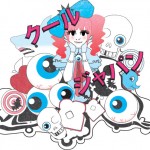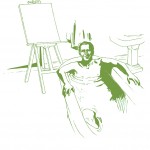EM: How do you think this experience is going to help you professionally?
KC: I think for me, at least, this is the closest thing you can have to a design-based job within school that counts for course credit as opposed to an internship. It’s something where you’re actually making things and you have a team behind you, with everyone assigned different responsibilities. This environment is similar to what’s going to happen next.
AC: As someone who’s really interested in designed objects and pursuing a career in object design, it’s like the class and this show marks our entry point into this world. Having your first show at the Milan Furniture Fair is like your first major professional show. It’s your coming out party. So that’s what I’m hoping for. Whether or not it goes well…
KC: It will.
AC: Whether or not it goes well, it’s going to be a special experience for all of us.
KC: Jing?
JO: I kind of look at it from a different perspective. I want to talk a little about the career development aspect. As a designer in the United States, most American design isn’t a huge fan of Milan. American design is more about being commercial and marketable. This class probably exists because the tradition of the AIADO department at SAIC leans more towards European design. Not conceptual, but really high-end design as opposed to more a more commercial American style. If I wanted to stay here and look for jobs, this Milan project might help me, it might not.
KC: I think it will. Usually on the first day of class you get a syllabus. On the first day of this class they give you a year long calendar with research, production, and shipping deadlines. It was a different format and in that way I’ve learned a lot about the real world.
AC: I think it might not necessarily land you a job, but you definitely learn tools that you will use in the future as a designer in any field. Or if you go into an art career, I think these are all things that you can take with you.
KC: And that way it’s not a surprise. We expect it to be like this during the next professional project we work on. It’s going to be just as busy.
JO: This class is like a half step further than other students will go during school because you get to realize your designs instead of just making a prototype.
EM: I wanted to go back to what you said about the school having a different design style than you think is common elsewhere in the country. Do all of you agree with that? I don’t really know much about the philosophy behind the design aspect of the school.
JO: I don’t really know either! I was just guessing!
KC: No, you’re right. In the design portion it’s European. In the Visual Communication Department, it’s all Swiss. All our teachers are very Swiss-based designers. Whatever is the strongest in Europe is what we’re learning.
AC: We also have a lot of professors that studied in Europe, or are from Europe originally. I think it makes sense. Design has always been valued over there in a different way than it has been in the United States. Without this European influence I don’t think it would be a department at this school. Our professor for this class, Jim TerMeer, went to school in Holland. It makes sense to me; it’s a good thing to have more speculative, thought-driven design.
KC: Everything that’s high-end here is because we’re looking at the Europeans. If something is clean-cut or really well designed, you’re like, “Wow this is so European.”
AC: Or Japanese. This school is really pushing an “art and design” nexus. So for us to be more focused on object design and less focused on industrial design is natural.
EM: How do you think the art and design sections at this school correlate and collaborate?
AC: In the past two years they’ve definitely opened up a lot more. People actually know that there is a designed objects department. Artists have started to accept digital fabrication processes like laser cutters or 3-D printing into their work a lot more. And those are processes that designers use all the time.
EM: So would you consider yourselves artists or designers?
KC: That is the hardest question.
AC: The artist-designer question has always been something in the back of my mind because I like to spend equal time in both departments. The mindset I had going into school was to try to be a designer, but I think I’ve always known that being an artist was part of who I was.
JO: I don’t know. I first came here to study design, and I remember I was working on a lighting project that had neon strips incorporated into steel and concrete. My teacher and classmates all interpreted it as an art piece instead of a design piece. I didn’t think of it that way at all until they said that. At first I really wanted to define myself as a designer instead of an artist. Then I realized that I couldn’t help it, it just happens naturally. There’s really no boundary.





















